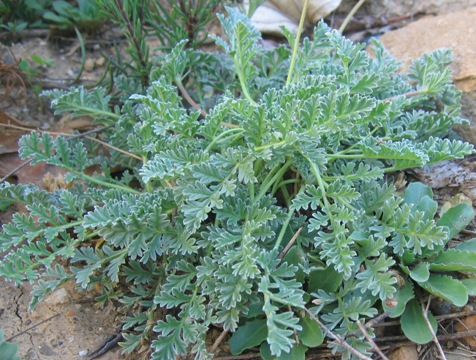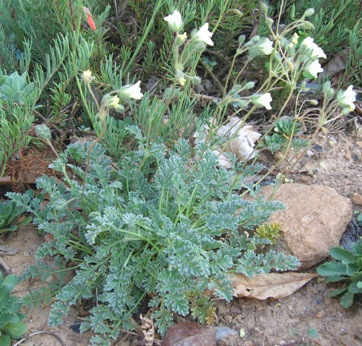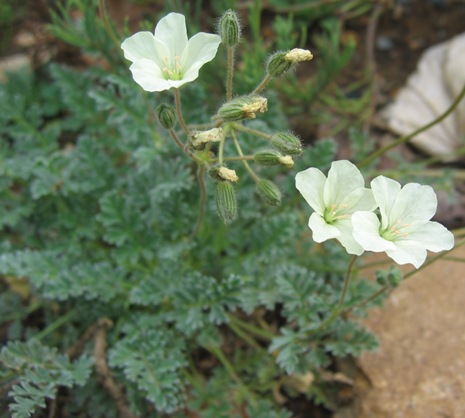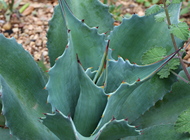 |
Erodium chrysanthum |
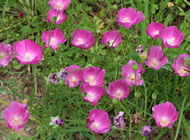 |
| Common name |
yellow storksbill |
| Family |
geraniaceae |
| Life cycle |
perennial (Z5-9) |
| Flowers |
pale yellow (spring-summer) |
| Size |
6" |
| Light |
sun |
| Cultural notes |
heat- and drought-tolerant |
Grayish-blue-green feathery foliage looks delightful in May. Starting the second half of the month, creamy paper-petaled flowers appear on delicate stilts above the low-growing tuft. Unfortunately it faded out of our garden after a year or two. I later learned that the plants are dioecious; since I had just one plant, I was never going to get seed (and indeed I didn't).
See the comment below for a cautionary remark on the identity of the plant described here.
|
This plant used to grow in our garden, but it slipped away... About my plant portraits
PlantLinks to other web pages about Erodium chrysanthum
Some particularly helpful links to other websites
Visitors to this page have left the following comments| Allan Robinson | Mar 20, 2014 | Hi, I just came across your article on Erodium chrysanthum. I consider the plant you have shown as E. chrysanthum a hybrid, somewhere related to the Erodium x lindavicum complex.
"Chrysanthum" means golden and I'm afraid the male plant in cultivation is a very pale yellow. Having studied Erodium chrysanthum in Greece over several years, I know what the species should look like. Please go to the Geraniaceae Group's website and view the article "In search of the golden fleece".
Thanks, Allan R
Thanks for the comment, Allan. I hope to grow the real thing sometime. |
| Richard Fleming | Dec 12, 2019 | It's so annoying that most plant sellers seem to think that hybrids are better. Why can't people just sell the true species? This is very irksome with tulips, for example. The true species always look better to me than the hybrids, especially the all-yellow ones.
I think people should choose from the multitude of flowering species instead of releasing so many Frankenplants, especially when those crowd out the real species (like with so-called species tulips and with daffodils).
It's a relatively rare case, in my opinion, that a hybrid is better. Sometimes they are but not often. Because nectar, not pollen, is the main draw for butterfly bushes that is one example where a non-seeding hybrid is preferable. The hybrids can put more energy into flowering and also tend to be more resistant to spotted beetles. Certain robust hybrid zinnias (like Forecast) are also great nectar sources for butterflies. But too often the hybrids have much worse wildlife value and also inferior aesthetics because people tried to improve what was already a flawless-looking flower.
There is so much arrogance with people where they think they can do better than nature. Most of the time they can't. |
I welcome comments about my web pages; feel free to use the form below to
leave feedback about this particular page. For the benefit of other visitors
to these pages, I will list any relevant comments you leave, and if
appropriate, I will update my page to correct mis-information. Faced with an
ever-increasing onslaught of spam, I'm forced to discard any comments including
html markups. Please submit your comment as plain text. If you have a
comment about the website as a whole, please leave it in my
guestbook. If you
have a question that needs a personal response, please
e-mail me.
Last modified:
May 17, 2014
Contact me
|


